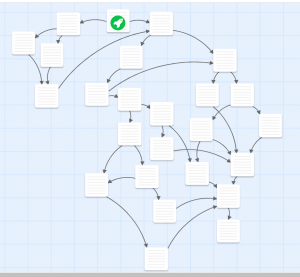
Twine: Catching a Gnarly Wave
I had heard of Twinery before, but had yet to try it out. In the beginning, it was fun to start playing around with the story and linking the steps together. Even with the instructions printed off and sitting beside me, things did not make sense until I actually started playing around with it, shaping what I was going to say and providing links and choices for the reader along the way. I found I almost needed to remind myself to provide a choice for the reader to choose, so they feel as if they have control of what they are actually choosing for the next steps of the story. In a way, this reminded me of putting a puzzle together, where the pieces needed to connect together to try and move onto the next step and attach another puzzle piece.
As I created the Twine, Catching a Gnarly Wave, I reflected on how the idea of what Bolter (2001) referred to as linear and closed script and how script has changed over time with our use of hypertext. I also reflected on the article by Miall and Dobson (2001) where they quoted (Landow 1997, p. 273) in saying that, “hypertext increases individual freedom,” because “users are entirely free to follow links wherever they please.” Using Twine to create a story allowed that freedom of looping ideas together and circling back to make another choice. As a child I loved Choose Your Own Adventure stories and I enjoyed how some of the choices I made linked together and how I could restart the story again and choose a new path. The ease of the Twine hyperlinks allows immediate direction and choice to the path I wanted to follow in the story. One thing I noticed is that in the story I used “I” over “You” to show more personalization and make the reader feel as if they are the central part of the story, whereas “you” makes it seem a little less personal.
Creating the Twine was fairly easy to navigate and I enjoyed how I was able to insert audio code into my story to try and give it a bit more life. I was able to insert a few sound bites, but the enjoyment soon disappeared as new soundbites were not working and it took me much longer than I thought to delete lines and lines and lines of audiocode. After a few more tries the whole Twine froze and eventually kicked me out. Good thing I had already saved a copy.
References:
Bolter, J. D., & EBSCOhost. (2001). Writing space: Computers, hypertext, and the remediation of print (2nd ed.). Lawrence Erlbaum Associates. https://doi.org/10.4324/9781410600110
Miall, D. S., & Dobson, T. (2001). Reading hypertext and the experience of literature. Journal of Digital Information, Retrieved from https://explore.openaire.eu/search/publication?articleId=issn13687506::feae30569d02fbf0a7451897e74be20b